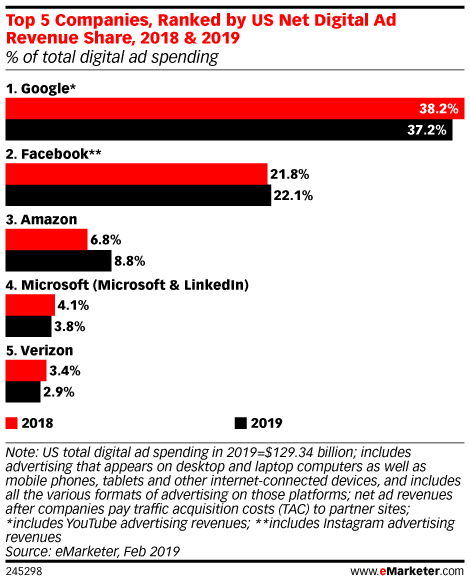2019 in digital marketing — soaring digital spending, privacy concerns, blockchain getting real
In 2019, digital ad spending surpassed traditional for the first time. Amid privacy concerns and the rise of blockchain, the landscape of digital marketing is evolving. Discover key trends and insights.

In 2019 advertisers are spending more on digital advertising than traditional. Privacy and fraud continue to be major concerns for the industry while AI and blockchain are getting traction and trying to offer solutions.
Landscape and revenue predictions
Digital advertising spend has been on the rise last year and numbers for 2019 are even more optimistic. According to eMarketer, US digital ad spend will hit $129.34 billion revenue for 2019, surpassing traditional ad spend for the first year. Digital advertising in UK in 2019 will also hit record numbers. Despite the backdrop of Brexit and the resulting economic uncertainty, Barclays forecasts that marketers will spend more on UK ads in 2019 than in 2018 — $19.6bn to be precise.
While more than half of the digital ad spending goes to Facebook and Google combined (50%+), scandals regarding how they share and protect user data, their corporate footprints, and the taxes they pay shook the two giants in 2018. This year their combined market share is expected to drop for the first time, revealing opportunities for other competitors.

What will influence digital advertising in 2019

There are several trends that are shaping the digital advertising landscape in 2019:
- GDPR and contextual advertising. The new European regulation on user privacy came into force last year but is yet to cause major changes in online advertising. Companies will no longer have the right to collect information about people without their explicit consent, meaning that, at least in theory, they will not be able to get enough data for segmentation, affinity categories creation and targeted ads. Experts believe that this will cause a rise in contextual advertising: determining the characteristics of a target audience based on the content of the web pages they visit. General data about the interests of visitors to that page gives advertisers a clear context of how to appeal to those visitors.
- Voice search paving the road for new niche — voice advertising. There are about 50 million Echos and Google Homes operating at the moment and the number is constantly growing. Voice ads are already a thing and in 2019 they may evolve towards partnerships with brands that will allow for organic use of the devices, peppered with ads directing consumers to specific products or services.
- 5G will accelerate video advertising. 5G is already undergoing its first phase of commercial deployment. The bandwidth of 5G is 1000mbps, which is 10 times more than its predecessor — 4G. 5G will boost almost everything that happens on the Internet and relies on lots of data, including drones, VR, self driving cars. The high bandwidth of 5G will enable the ad tech ecosystem to load ads faster, reducing the millisecond delay that usually makes the user move away from the site. It also means 4K video delivered via mobile networks. Imagine what will happen when Donald Trump’s 6G dream comes true…
- Criticism on FAGA continues — Facebook and Google managed to stir too many conflicts involving data breaches, protection and sharing of user data, corporate footprints and taxes. While half the digital ads spend happens on the two platforms, many advertisers are getting cautious and are already looking for alternatives. Amazon’s own advertising network is doing really well and its US ad business is expected to grow by 50% this year.
- AI on the rise — AI is a strong factor in programmatic advertising and it is set to develop even further in 2019, eliminating the guesswork in targeting, improving personalization of ads and improving engagement.
Will blockchain “make digital advertising great again”?
The programmatic ad tech industry has been struggling with transparency and ad fraud for years now, and some industry executives believe that at the moment ad fraud is worse than ever. In 2018 alone, fraudulent activities caused advertisers $19 billion loss. Fraudsters are coming up with more advanced schemes all the time and the rise of AI and machine learning give better chances for advertisers to fight scammers, but also better “weapons” in the hands of the latter.
Suspicious agents around the world and mostly in India (responsible for 8.7% of global digital ad-fraud in 2018) are coming up with ad fraud schemes every day and the most common ones are ad spoofing, unauthorised reselling of ad inventory and fake traffic.
Ads.txt, the IAB-approved file on their servers that lists all the companies allowed to sell the publisher’s inventory, has seen a remarkable rise in 2018. The project has gained traction among publishers and advertisers alike. As of February 2018, 51% of websites worldwide had adopted ads.txt. While Ads.txt is a simple and effective tool against domain spoofing, DoubleVerify announced that it has uncovered a new bot network that perpetrates fraud by circumventing ads.txt protections.
As Bannerflow pointed out on their blog “Ads.text is just a band-aid and as a trend, probably as fleeting as Pokemon Go”.
The real opportunity for fixing digital advertising’s flaws lies in blockchain and it seems that things are getting real in 2019.
Blockchain introduces ad tech to some benefits of decentralization that can solve the most common issues faced by advertisers and publishers:
- Transactions that run across computers worldwide mean that records cannot be altered retrospectively.
- Legitimacy of publishers and website/app visitors can be easily verified with unique cryptographic pairs
- Unique cryptographic pairs may allow anonymity in the context of GDPR
- Blockchain-fueled decentralization can reduce the number of middlemen in the traditional ad network, improving transparency and reporting
Many companies promised to improve digital advertising (and almost everything imaginable) with blockchain during the crypto boom, but the few that have actually delivered real products seem to do things right:
- Brave Software’s Brave Browser has hit 20 million downloads and users of the browser can now earn the Basic Attention Token a.k.a. BAT for basically looking at and clicking on ads.
- We introduced the AdEx protocol back in September 2018 with the aim of facilitating trading of advertising space/time, as well as the subsequent verification and proof that it actually occurred. In the beginning of 2019 we made a solid progress with the protocol and as a result there is a working AdEx advertising platform already on which advertisers and publishers can benefit from real traffic, real-time tracking and reporting directly accessible to platform users. Advertisers and publishers also don’t need intermediaries on the AdEx platform, cutting unnecessary costs.
- In Q2 we are releasing the stable version of the AdEx platform and onboarding advertisers and publishers.
Other blockchain ad tech startups like AdChain, KindAds and AdBank are following and we expect to see some real improvements in ad tech in 2019 thanks to decentralization. We even decided to partner with KindAds to share know-how and educate advertisers, publishers and agencies about the benefits of decentralization.
2019 may turn to be a really interesting year for digital advertising and turning point for the adoption of blockchain technology, so keep a close eye on what is happening in the industry, as we will be reporting from the front line.
Interested in AdEx? Follow us:
X (Twitter) | Telegram | Reddit | Facebook | LinkedIn | Discord
